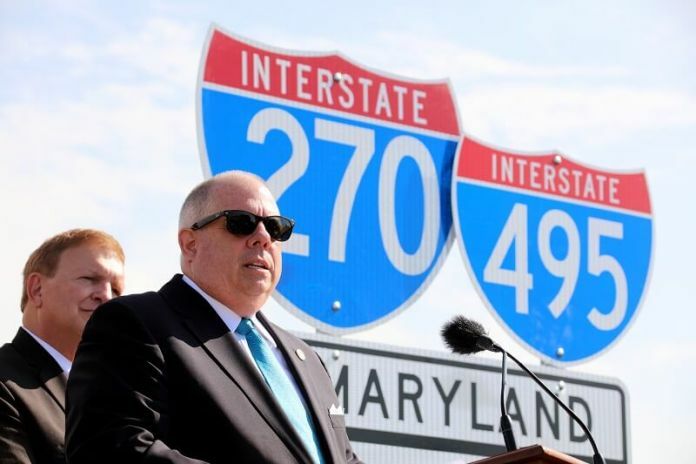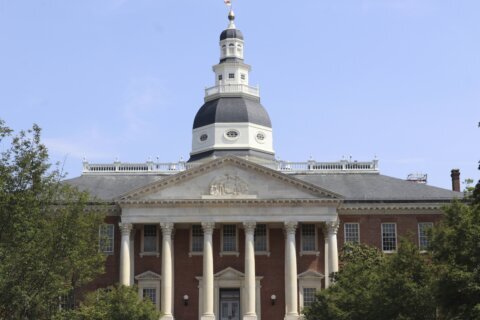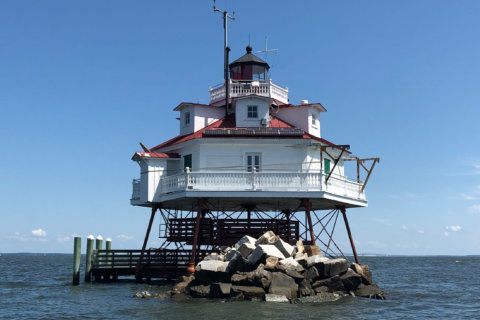This article was republished with permission from WTOP’s news partners at Maryland Matters. Sign up for Maryland Matters’ free email subscription today.

This content was republished with permission from WTOP’s news partners at Maryland Matters. Sign up for Maryland Matters’ free email subscription today.
Two Montgomery County lawmakers suggested on Tuesday that an analysis of the state’s controversial Capital Beltway/I-270 proposal is being withheld by top transportation officials in order to make it harder to stop the project.
And a legislative budget analyst said that Republican Gov. Lawrence J. Hogan’s oft-repeated claim — that the state lacks the resources to widen the two highways and replace the American Legion Bridge — has never been put to the test.
Their comments were made during a hearing held by two General Assembly subcommittees that oversee transportation policy.
The legislature is in the midst of a 30-day window they have to review a design contract that the Maryland Department of Transportation signed with Accelerate Maryland Partners (AMP), a consortium led by Transurban and an Australian financier.
The $54 million agreement is expected to go before the Board of Public Works in the coming weeks.
A legislative analyst told lawmakers that MDOT first promised a study, known as a “value for money” analysis, in 2019 but did not follow through.
The agency recommitted to provide the study last month, Department of Legislative Services analyst Matt Mickler told lawmakers, but only “in conjunction with… [a] final design plan for construction, financing and operations.”
“This would mean that we would be receiving the value-for-money analysis after entering a Phase Developer Agreement” for the project, he said.
Mickler said the study would look at whether taxpayers would be better served using public-funding for the project or pursuing the public-private partnership scheme Hogan unveiled in 2017.
Delegates Marc A. Korman (D-Montgomery) and Jared Solomon (D-Montgomery) said such a review is only valuable before the state begins entering long-term contracts.

“We will get an analysis of whether it is better for us to go with a private company for 50-to-100 years, versus a public project as we’ve always done, after we’ve already signed a contract with a private entity to begin work,” Solomon said.
Transportation Secretary Greg Slater defended the state’s approach. He told lawmakers that having a final construction contract in hand will allow MDOT to make a fuller comparison.
“Then we’re able to do that value-of-money analysis in looking at a public option versus a ‘P3’ option — and that analysis will come to you with that agreement,” he said.
Korman, chairman of the House Appropriations Subcommittee on Transportation and the Environment, questioned “the timing of it and how valuable it’s going to be, at that time, to have a value-of-money study.”
Hogan, who has 18 months remaining in his second term, is eager to get contracts inked while he’s in office.
His proposal enjoys robust support from many transportation advocates and the business community, who see it as a way of addressing some of the nation’s most-congested roads without using tax dollars.
But his plan has taken a beating from local planners and political leaders, transit advocates and environmentalists.
Earlier this month, the National Capital Region Transportation Planning Board removed the I-495/I-270 plan from a federal environmental analysis that is needed for the “express lanes” project to get necessary financing.
In a memo to lawmakers, top legislative analysts said MDOT has indicated that a delay in getting the project reinserted into the capital region’s transportation plan “could cause AMP to withdraw from or reduce its offer to the State… including the potential to build the Phase 1 South improvements at no cost to the State, the $145 million [development rights fee, a payment to the state], and other financial and environmental enhancements.”
Hogan financing claim is questioned
In the four years since he unveiled his plan to add variably-priced toll lanes to portions of I-495 and I-270, Hogan has insisted that Maryland lacks the ability to finance the multi-billion dollar project, and that only the deep pockets of the private sector can get the job done.
Budget analyst Steve McCulloch said Hogan’s claim “is not quite the whole story.”
“The private sector is not really funding any part of this project,” he said. “They are financing this project, and they will be fully repaid over this 50-year term. So the money that is needed for this project is out there, in the pockets of the toll-users that will use this facility.”
McCulloch said the state could raise the Maryland Transportation Authority’s debt limit to help meet the project cost but there likely would still be a gap between the expense the state would incur and what investors would be able to finance.
He said the size of the gap is unknown because “the analysis hasn’t been done,” or if it has, it hasn’t been released to the public and the General Assembly.
Maryland Transportation Authority Chief Financial Officer Deb Sharpless cautioned that the authority maintains high debt-service coverage in order to maintain its high credit rating.
“If we finance this project… we would have to raise tolls substantially with our existing facilities, because we would need to generate revenue to maintain [current] coverage,” she said.
In addition, she said, under a P3, the developer assumes the risk that tolls aren’t enough to repay investors. “If the vehicles are not on the roadway, that’s their risk,” she said. “If MdTA would finance it, the state would be taking that risk.”
“That uncertainty that exists would very likely reduce our credit rating,” Sharpless added.
Franchot remains likely swing vote
The Board of Public Works is made up of Hogan, Treasurer Nancy K. Kopp (D), a likely “no” vote, and Comptroller Peter V.R. Franchot (D), a candidate for governor in 2022 and the likely swing vote.
A Franchot staff person monitored the tense four-hour hearing, a session that saw Korman, an attorney, grill Slater and his team over a dozen aspects of the proposal.
Korman began the session by calling another high-profile P3, the half-built Purple Line, “a disaster.”
“The project is years behind schedule, litigation between the state and the contractor is rampant, and we still do not know the true cost of that project,” he said of the half-built light rail link between New Carrollton and Bethesda.

.
“Part of the issue was that the state and the contractor did not agree about the cost of the project and what needed to be included before it began, and unfortunately we might be facing a situation now where we know even less going into the next P3.”
In a briefing for lawmakers, Robert Puentes, head of the non-profit Eno Center for Transportation, said that public-private partnerships are frequently misconstrued.
“They seem to be alternatively framed as either a panacea to all of America’s infrastructure challenges or a corporate takeover of public assets,” he said. “The reality is that they’re neither one of those things.”
P3’s are “rarely the lowest-cost way to procure infrastructure,” Puentes told the panel. “But a well-structured P3 can deliver better value for the public dollar” because projects tend to get done more quickly or through improved techniques.
He described Maryland’s P3 law, which was passed in 2013 to pave the way for the Purple Line, as “solid.”







